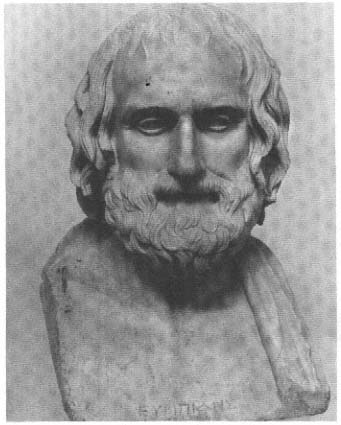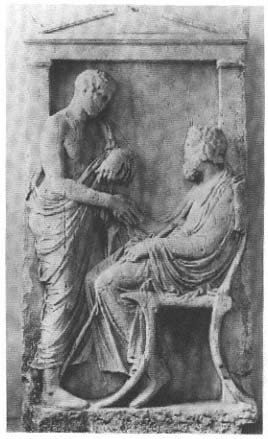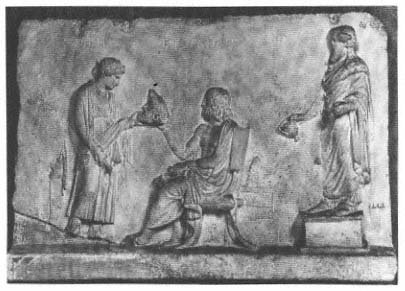Euripides: The Wise Old Man
For the portrait of Euripides in Lycurgus' dedication the only candidate, on stylistic grounds, is, in my view, the inscribed copy known as the Farnese type (fig. 30).[20] It shows the poet as an elderly man with bald pate, a fringe of long hair, and subtle indications of aging in the face. Not just an ordinary old man, however, but a kalos geron, like the

Fig. 30
Portrait herm of the playwright Euripides. Roman copy
of a statue ca. 330 B.C. Naples, Museo Nazionale.
earlier portrait of Homer. In the highly conventional vocabulary of Attic gravestones, this type of old man is often shown seated, especially when he is the principal person being commemorated. (fig. 31). This is an allusion not just to physical weakness, but to the status and authority of the older man within the family (oikos ) and the polis.[21] The dignified, seated position of the elderly paterfamilias is, furthermore,

Fig. 31
Attic gravestone of Hippomachos and Kallias.
Piraeus, Museum.
an accurate reflection of the rituals of daily life. We may be reminded of the dignified figure of old Kephalos, at the beginning of Plato's Republic, who receives his guests seated on a diphros (Rep. 328C, 329E).
The portrait of Euripides of the Farnese type actually appears once on a seated figure, on a relief of the first century B.C. (fig. 32), which, on the basis of other elements, such as the chair and the overall style, could reflect an original of the late fourth century. The figure is com-

Fig. 32
Votive relief (?) of the seated Euripides, with the personification of the stage
(Skene ) and an archaistic statue of Dionysus. Istanbul, Archaeological Museum.
bined with two that are stylistically later in date, a personification of the stage (Skene ) and an archaizing statue of Dionysus, an eclectic mixture in which, we may well suspect, lurks a quotation of a well-known Classical portrait statue of a poet. Indeed, the classicistic artists of such reliefs as a rule did not "invent" any new figure types. The book roll and the pillow are already elements in the iconography of Late Classical grave stelai. And the mantle drawn up over the back, a standard characteristic of old men, as we see it on the herm in Naples, find a parallel on this relief.[22] In his raised right hand, Euripides takes a mask proffered to him by Skene . In the original portrait statue, to judge from the iconography of the gravestones, that hand could have held the old man's staff.
If we imagine the Euripides statue in this way, then we may well ask why he alone of the three tragedians was shown as an old man. It is
true, of course, that Euripides lived to be eighty, but then Sophocles was ninety, and Aeschylus did not die young either. Euripides in his lifetime was clearly ranked behind Aeschylus and Sophocles and was even accused by his contemporary Aristophanes of lacking any citizen virtues. But in the course of the fourth century, his reputation underwent an enormous transformation, so that by the time of Lycurgus he was considered the most outstanding of the great tragedians (Aristotle calls him tragikotatos at Poetics 1453a29f). For Plato and Aeschines he was simply the wise poet, and later he would even be called by Athenaeus the philosopher of the stage (skenikos philosophos ).[23] Wisdom and insight are precisely the qualities that set the elderly apart from younger men; this is why they enjoyed special privileges both in the life of the city and within the family. So, for example, men over fifty had the right to speak first in the Assembly (Aeschin. In Tim. 23).[24] Not by accident, the relatively few instances on Attic gravestones of this period of a figure holding a book roll are always seated older men like Euripides. That is, they are the only individuals in this highly stylized medium of the bourgeois self-image who are celebrated for their education and knowledge. The aged Euripides would thus have been shown seated to emphasize his extraordinary wisdom relative to the other two tragedians. When we try to imagine the three as a single monument, rather than as separate statues, a grouping of two standing figures and one seated would, by the standards of the gravestones, be a perfectly acceptable one.
If this was indeed the principal message conveyed by Euripides' portrait, we might well expect in his facial physiognomy a clear characterization as an intellectual. Scholars have often seen in this face framed by heavy locks of hair an expression of the supposed melancholy and pessimism that were attributed to Euripides even in antiquity on the basis of his plays, or, at least, as Luca Giuliani recently put it, a definite "Denkermimik."[25] But, once again, modern viewers, influenced by their own expectations, see more than the artist actually intended. Euripides is shown as an older man, and, as on some images of old men on the gravestones, the barely visible wrinkles in the forehead and the eyebrows gently drawn together may suggest a certain element of mental effort or contemplation, but nothing more. A comparison with
the earlier portraits of intellectuals, such as those of Pindar (fig. 7), Lysias, and Thucydides (fig. 42),[26] makes it clear that the sculptor was in no way trying to express a specific kind of mental concentration. On the contrary, the very "normality" of Euripides' old man's face presumably once again reflects the statue's true intentions. Like Aeschylus and Sophocles, Euripides is portrayed as an Athenian citizen, a venerated ancestor, just like those so prominently displayed on the grave monuments of wealthy families at the Dipylon. It seems appropriate, in this context, that in his one preserved oration Lycurgus praises Euripides not so much as a poet, but rather as a patriot, because he presented to the citizenry the deeds of their forefathers as paradeigmata "so that through the sight and the contemplation of these a love of the fatherland would be awakened in them."[27]
Thus in the monument proposed by Lycurgus in the very place where the Assembly met, the three famous poets were presented as exemplars of the model Athenian citizen, probably in three different guises: Sophocles as the citizen who is politically engagé, Aeschylus as the quiet citizen in the prime of life, and Euripides as the experienced and contemplative old man. Their authority, of course, grew out of their fame as poets, yet they are celebrated not for this, but instead as embodiments of the model Athenian citizen.
I should add that most of what I have been suggesting remains valid even if one questions the identification of the portrait of Aeschylus or the association of the portrait of Euripides with Lycurgus' dedication. Even if the context were otherwise, as we shall see, nothing would change in the basic conception of these portraits. The only loss would be in the programmatic interpretation within the framework of Lycurgus' political goals.